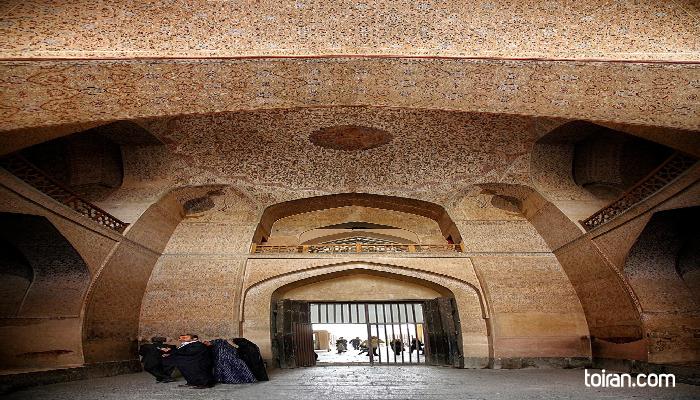Ali Qapu (Imperial Gate) Palace is a six-story monument on the western side of Naqsh-e Jahan Square where the Safavid Shah Abbas I (1571-1629) spent most of his time, entertained visitors and foreign emissaries and used the upper galleries to watch polo games and military parades.
Ali Qapu is actually a pavilion and the entrance to the royal quarters, which stretched from Naqsh-e Jahan Square to the Chahar Bagh Boulevard. Some say the palace’s name is actually Ali’s Gate’ because when Shah Abbas I replaced the door of the Imam Ali (PBUH) (599-661) shrine in Najaf with a new silver one, he brought back its old door and installed it in Ali Qapu Palace.
According to some accounts, the original structure was a simple Timurid (1370–1507) one which was expanded by Shah Abbas I. It is said that after celebrating his first Nowruz (Persian New Year) in the palace in 1597, Shah Abbas decided to make it his permanent residence and had the palace modified accordingly.
Master miniature painter Reza Abbasi (1565-1635) was commissioned to decorate the interior of the building. The flower, bird, and animal motifs adorning the walls and ceilings of Ali Qapu are the work of this Safavid era painter and his apprentices.
When the Safavid monarch built Sheikh Lutfollah Mosque, a tunnel was built under Naqsh-e Jahan Square to connect Ali Qapu Palace and the private royal mosque, allowing the Safavid royal to avoid a public walk across the square to reach the mosque.
Shah Abbas’ successors made further additions to Ali Qapu in five stages. The palace now has six stories. However, some consider the roof of the palace, which offers a panoramic view of the city, as its seventh story.
Administrative offices were located on the first floor of Ali Qapu. The third floor of the palace has a hall with 18 columns covered in mirrorwork and a ceiling embellished with delicate paintings.
The palace boasts an acoustic music room on its sixth floor where royal reception and banquets were held and various ensembles performed for the Safavid king. The ceiling of the music room has cut out stucco decorations of vases and goblets which served to enhance the sound of music played for the King.
With a height of 48 meters, Ali Qapu Palace was once the tallest building in Isfahan and has been registered along with Naqsh-e Jahan Square as a UNESCO World Heritage Site.









One of the wonders of Persian Empire architecture is definitely Ali Qapu Palace. One can wonder through history just walking up the stairs and when you get to the Balcony (Ivan) on the fifth floor you are faced with the magical view of all the Naqhshe Jahan Square it is almost surreal. The best craftsmen of the time were hired to work on each detail of the palace and at top you will enter the Acoustic room where the King used to enjoy live music and the stucco cuttings in the dome of the room helped the echo effect and one can wonder how they came up with this technology way back then? It is a registered Unesco World Heritage Site and make sure to take the climb the view is worth it :)
نمای میدان نقش جهان از ایوان عالی قاپو فوق العاده است. از آنجا می توان به شکوه مسابقات چوگان که در گذشته های نه چندان دور انجام میشد پی برد.
Wonderful and amazing architecture used in this structure and when you get up there the view of the square and people is a wonder :)
Amazing tiles and i really loved the acoustic room at top where the king used to enjoy live music :)
Amazing view of the whole Naqshe Jahan Square from the balcony on top.
http://20mg-levitraforsale.com/ - 20mg-levitraforsale.com.ankor usbuy-ventolin.com.ankor http://generic-levitracheapest-price.com/
http://20mg-levitraforsale.com/ - 20mg-levitraforsale.com.ankor usbuy-ventolin.com.ankor http://generic-levitracheapest-price.com/